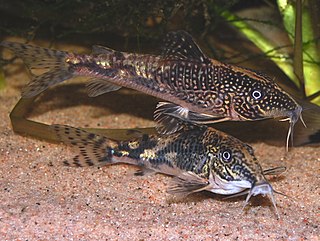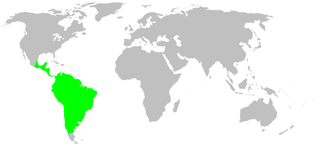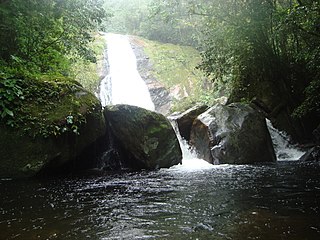
Corydoras is a genus of freshwater catfish in the family Callichthyidae and subfamily Corydoradinae. The species usually have more restricted areas of endemism than other callichthyids, but the area of distribution of the entire genus almost equals the area of distribution of the family, except for Panama where Corydoras is not present. Corydoras species are distributed in South America where found east of the Andes to the Atlantic coast, from Trinidad to the Río de la Plata drainage in northern Argentina. Species assigned to Corydoras display a broad diversity of body shapes and coloration. Corydoras are small fish, ranging from 2.5 to 12 cm in SL., and are protected from predators by their body armor and by their sharp, typically venomous spines.

Corinnidae is a family of araneomorph spiders, sometimes called corinnid sac spiders. The family, like other "clubionoid" families, has a confusing taxonomic history. Once it was a part of the large catch-all taxon Clubionidae, now very much smaller. The original members of the family are apparently similar only in that they have eight eyes arranged in two rows, conical anterior spinnerets that touch and are generally wandering predators that build silken retreats, or sacs, usually on plant terminals, between leaves, under bark or under rocks.

Morretes is a small historic city near the coast of the Brazilian state of Paraná. It has a population of around 18,000 people. It is famous for its restaurants, especially a traditional dish called barreado. It is also the home of many historical monuments.

Astraptes is the genus of flasher butterflies. They belong to the skipper butterfly subfamily Eudaminae, which was long included with the spread-winged skippers (Pyrginae) as a tribe. They are found in the Nearctic and Neotropical ecozones.

Barychelidae, also known as brushed trapdoor spiders, is a spider family with about 300 species in 42 genera. Most spiders in this family build trapdoor burrows. For example, the 20 millimetres (0.79 in) long Sipalolasma builds its burrow in rotted wood, with a hinged trapdoor at each end. The 10 millimetres (0.39 in) long Idioctis builds its burrow approximately 5 centimetres (2.0 in) deep, just below the high tide level, sealing the opening with a thin trapdoor.

Scleromystax is a genus of fish in the family Callichthyidae endemic to small tributaries from several coastal river basins draining the southern and southeastern regions in Brazil. Most of the species of Scleromystax are highly sexually dimorphic; males have developed odontodes inserted in fleshy papillae on the preopercular-opercular region and the dorsal and pectoral fins are 2–3 times as long as those of females. S. salmacis is an exception, as its sexually dimorphic features are subtle and non-remarkable.
Brachycephalus pernix is a species of frog in the Brachycephalidae family endemic to Brazil; it is known from Morro do Anhangava and Morretes, Paraná and occurs at 450 meters above sea level. It is thought to occur more widespread than currently known.
Gonyostomus is a genus of air-breathing land snails, terrestrial pulmonate gastropod mollusks in the family Strophocheilidae endemic to Brazil.

Megalobulimus is a genus of air-breathing land snail, a terrestrial gastropod mollusk in the subfamily Megalobuliminae within the family Strophocheilidae.

Cerionidae is a family of air-breathing land snails, terrestrial pulmonate gastropod mollusks in the superfamily Urocoptoidea.

Senoculus, also called bark hunters, is a genus of Central and South American araneomorph spiders and the only genus in the family Senoculidae. It was first described by Taczanowski in 1872.
Agaronia travassosi is a species of sea snail, a marine gastropod mollusk in the family Olividae, the olives.

Agaronia is a genus of sea snails, marine gastropod mollusks in the family Olividae.
Antônio Ricardo dos Santos Filho was a Brazilian politician and industrialist. He was the first vice-president of the Paraná Province, between December 29, 1887, and February 9, 1888.

Megalobulimus paranaguensis is a species of air-breathing land snail, a terrestrial gastropod mollusk in the family Strophocheilidae.

The Pau Oco State Park is a state park in the state of Paraná, Brazil. It protects an area of Atlantic Forest. The main attraction is the Salto da Fortuna, a waterfall.













